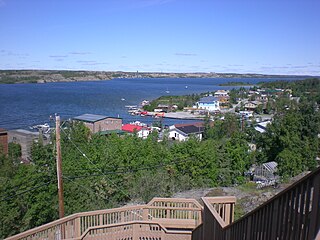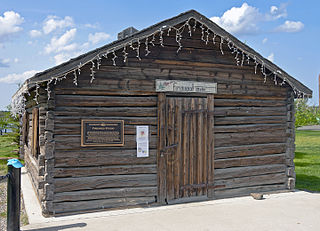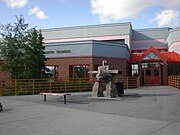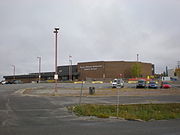
Brewster County is a county located in the U.S. state of Texas. It is in West Texas and its county seat is Alpine. It is one of the nine counties that comprise the Trans-Pecos region, and borders Mexico. Brewster County is the largest county by area in the state - at 6,192 square miles (16,040 km2) it is over three times the size of the state of Delaware, and more than 500 square miles (1,300 km2) bigger than Connecticut.

Yellowknife is the capital, largest community, and only city in the Northwest Territories, Canada. It is on the northern shore of Great Slave Lake, about 400 km (250 mi) south of the Arctic Circle, on the west side of Yellowknife Bay near the outlet of the Yellowknife River.

Blakely is a city and the county seat of Early County, Georgia, United States. As of 2020, its population was 5,371. It is located approximately halfway between Columbus and Tallahassee, Florida on U.S. Route 27.

Maunawili is a residential census-designated place (CDP) in the City & County of Honolulu, Koʻolaupoko District, Island of Oʻahu, Hawaii, United States. As of the 2020 census, the CDP had a population of 2,026. Situated mauka of Kalanianaʻole Highway between Castle Junction and Castle Hospital, Maunawili is nearly all private homes, schools, and a few churches; horse stables complete the rural setting. There are no commercial establishments. However, residents are only minutes from Kailua.

La Salle Township is a civil township of Monroe County in the U.S. state of Michigan. The population was 4,639 at the 2020 census.

Navarro is a town in Navarro County, Texas, United States. The population was 232 at the 2020 census.

Great Barr Hall is an 18th-century mansion situated in the Great Barr district of Pheasey, Walsall, West Midlands, England. It has associations with the Lunar Society and is a Grade II listed building. It is, however, in a very poor state of repair and is on the Buildings at Risk Register.
Slavey is a group of Athabaskan languages and a dialect continuum spoken amongst the Dene peoples of Canada in the Northwest Territories – or central Denendeh – where it also has official status. The languages are primarily written using a modified Latin script, with some using Canadian Aboriginal syllabics. In their own languages, these languages are referred to as: Sahtúgot’įné Yatı̨́, K’ashógot’įne Goxedǝ́ and Shíhgot’įne Yatı̨́ in the North, and Dené Dháh, Dene Yatıé or Dene Zhatıé in the South.

Hay River, known as "the Hub of the North", is a town in the Northwest Territories, Canada, located on the south shore of Great Slave Lake, at the mouth of the Hay River. The town is separated into two sections, a new town and an old town with the Hay River/Merlyn Carter Airport between them. The town is in the South Slave Region, and along with Fort Smith, the town is home to one of the two regional offices.

The Wildcat Cafe is a vintage log cabin structure in Yellowknife, Northwest Territories, Canada and represents the mining camp style of early Yellowknife. The structure, which houses a summer restaurant, is located in what was then the central business district of the city. It is a City of Yellowknife Heritage Building, designated in 1992. First opened in 1937 by owners Willie Wylie and Smokey Stout, it is the oldest restaurant in Yellowknife. Subsequent owners were Carl and Dorothy Jensen (1939–1942) and Mah Gow (1942–1951), Yellowknife's first recorded Chinese resident. The cafe closed in 1951 with the illness of Mr. Gow. The building was saved from demolition in the late 1950s when a small group of Yellowknifers fought to have it protected as a heritage site. By 1970 no work had been done to restore the abandoned cabin and it was in poor shape when a new generation of concerned citizens lobbied for its protection. It was soon renovated and reopened as a functional restaurant in 1979. The Old Stope Association, a non-profit heritage society, was responsible for its operation in the 1970s–1980s, and today it is managed by the Wildcat Cafe Advisory Committee. In 1992, the cabin was declared a heritage site as an important old building in Yellowknife and the city took ownership. It is one of Yellowknife's most popular tourist attractions.

Behchokǫ̀, officially the Tłı̨chǫ Community Government of Behchokǫ̀, is a community in the North Slave Region of the Northwest Territories, Canada. Behchokǫ̀ is located on the Yellowknife Highway, on the northwest tip of Great Slave Lake, approximately 110 km (68 mi) northwest of Yellowknife.

The history of the Northwest Territories covers the period from thousands of years ago to the present day. Prior to European colonization, the lands that encompass present-day Northwest Territories were inhabited for millennia by several First Nations. European explorers and fur traders began to explore the region since the late-16th century. By the 17th century, the British laid claim to both the North-Western Territory and Rupert's Land; and granted the Hudson's Bay Company a commercial fur trade monopoly over the latter region.

The Yellowknife Catholic School Board is the religious school board responsible for Catholic schools in Yellowknife, Northwest Territories, Canada. The board is made up of a chair and five other elected members.
Hay River Reserve is one of only three Indian reserves in Canada's Northwest Territories. Located in the South Slave Region, it is a Slavey community with a population of 259, of which the majority are First Nations and some Métis, at the 2021 Canadian census, a 16.2% decrease from the 2016 census. The main languages on the reserve are South Slavey, and English. In 2017 the Government of the Northwest Territories reported that the population was 329, resulting in an average annual growth rate of 0.4% between 2007 and 2017.

The Fireweed Studio is a log cabin in Yellowknife, Northwest Territories, Canada, located in Somba K'e Park near City Hall. It was built in the late 1930s to house explosives at what later became Giant Mine, and later moved to its present location. In 1996 it was listed on the Canadian Register of Historic Places; two years later it was designated a city Heritage Building for its status as a well-preserved remnant of the city's early years.

The first building used as a school in Yellowknife, Northwest Territories, Canada, is currently located on Franklin (50th) Avenue at the south end of New Town, the city's downtown section. It is a small log cabin dating to the mid-1930s. It was designated a City of Yellowknife Heritage Site in 1998, and listed on the Canadian Register of Historic Places in 2004.
The D.C. Women's Hall of Fame was a project supported by the D.C. Commission for Women and meant to honor the achievements of women from the District of Columbia. Eight women were inducted into the hall of fame in its first year, 1988. Women were chosen for making "significant contributions in the fields of community and public service, education, health or labor." The hall of fame can be seen in the Dr. Mildred E. Gibbs lecture hall at the Charles Sumner School.
























